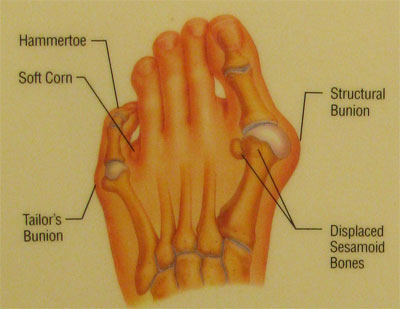TREATMENTS - BUNIONS
Hallux Abducto Valgus
INTRODUCTION
Hallux Valgus is a condition which affects the joint at the base of the big toe. The condition is commonly called a bunion. The bunion actually refers to the bump that grows on the side of the first metatarsophalangeal (MTP) joint. In reality, the condition is much more complex than a simple bump on the side of the toe. Interestingly, this condition almost never occurs in cultures that do not wear shoes. Pointed shoes, such as high heels and cowboy boots, can contribute to the development of hallux valgus. Wide shoes, with plenty of room for the toes, lessen the chances of developing the deformity and help reduce the irritation on the bunion if you already have one. However, shoes alone are not "solely" to blame for the development of bunions. Abnormal foot function comes into play in the development of almost all bunions, and the most common abnormality is over-pronation or excessive flattening of the foot, easily correctable with an orthotic.

ANATOMY
The term hallux valgus actually describes what happens to the big toe. Hallux is the medical term for "big toe", and valgus is an anatomic term that means the deformity goes in a direction away from the midline of the body. So, in hallux valgus, the big toe begins to point towards the outside of the foot. As this condition grows worse, other changes occur in the foot that make the problem worse. The bone just above the big toe, the first metatarsal, usually develops too much of an angle in the other direction. This condition is called metatarsus primus varus. Metatarsus primus means "first metatarsal", and varus is the medical term that the deformity goes in a direction towards the midline of the body. This creates a situation where the first metatarsal and the big toe now form an angle with the point sticking out at the inside edge of the ball of the foot. The bunion that develops is actually a response to the pressure from the shoe on the point of this angle. At first the bump is made up of irritated, swollen tissue that is constantly caught between the shoe and the bone beneath the skin. As time goes on, the constant pressure may cause the bone to thicken as well, creating an even larger lump to rub against the shoe.
SYMPTOMS
The symptoms of hallux valgus usually center around the bunion. The bunion is painful. The severe hallux valgus deformity is also distressing to many, and becomes a cosmetic problem. Finding appropriate shoewear can become difficult, especially for women who desire to be fashionable, but have difficulty tolerating fashionable shoewear. Finally, increasing deformity begins to displace the second toe upward, and may create a situation where the second toe is constantly rubbing on the shoe.
TREATMENT
Treatment of hallux valgus nearly always starts with adapting the shoewear to fit the foot. In the early stages of hallux valgus, converting from a pointed toe shoe to a wider box toe shoe may arrest the progression of the deformity. The pain that arises from the bunion is due to pressure from the shoe. Treatment focuses on removing the pressure that the shoe exerts on the deformity. Wider shoes reduce the pressure on the bunion. Bunion pads may reduce pressure and rubbing from the shoe. There are also numerous devices, such as toe spacers, that attempt to splint the big toe and reverse the deforming forces.
If all conservative measures fail to control the symptoms, then surgery may be suggested to treat the hallux valgus condition. There are well over 100 surgical procedures described to treat hallux valgus. The basic considerations in performing any surgical procedure for hallux valgus are: to remove the bunion to re-align the bones that make up the big toe to balance the forces so the deformity does not return
In some very mild cases of bunion formation, surgery may only be required to remove the bump that makes up the bunion.
It is more likely that re-alignment of the big toe will also be necessary. The major decision that must be made, is whether or not the metatarsal bone will need to be cut and re-aligned as well. The angle made between the first metatarsal and the second metatarsal is used to make this decision. The normal angle is around 9-10 degrees. If the angle is 13 degrees or more, the metatarsal will probably need to be cut and realigned.
This effectively reduces the angle between the first and second metatarsal bones, narrowing the foot. The bone is held in the desired position with a metal screw or pin.
In more severe bunion deformities, where the foot has widened considerably and the big toe is way out of alignment, the first metatarsal is cut at the near end of the bone.
The bone is re-aligned and held in place with screws or metal pins until it heals. A cast is worn and the patient walks with crutches or a walker, not bearing any weight on this foot or an extended period of time. Again, this reduces the angle between the first and second metatarsal bones.
Re-alignment of the big toe is then done by releasing the tight structures on the lateral side of the first MTP joint. This includes the tight joint capsule and the tendon of the adductor hallucis muscle. As you can see, this muscle tends to pull the big toe inward. The toe is realigned and the joint capsule on the medial side of the big toe is tightened to keep the toe straight.
Once the surgery is complete, it will take about eight weeks before the bones and soft tissues are healed.
After surgery is completed, it is essential that the two factors that caused the bunion originally be eliminated: Tight shoes must be avoided and abnormal foot function must be corrected.
|


